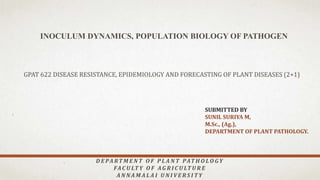
INOCULUM DYNAMICS, POPULATION BIOLOGY OF PATHOGEN
- 1. INOCULUM DYNAMICS, POPULATION BIOLOGY OF PATHOGEN SUBMITTED BY SUNIL SURIYA M, M.Sc., (Ag.), DEPARTMENT OF PLANT PATHOLOGY. GPAT 622 DISEASE RESISTANCE, EPIDEMIOLOGY AND FORECASTING OF PLANT DISEASES (2+1) D E PA RT M E N T O F P L A N T PAT H O LO GY FAC U LT Y O F AG R I C U LT U R E A N NA M A L A I U N I V E R S I T Y
- 2. INOCULUM DYNAMICS • An epidemic has been defined as any increase of disease in a population. A similar definition of an epidemic is the dynamics of change in plant disease in time and space. The study of epidemics and of the factors that influence them is called epidemiology • The combination of three factor (Susceptible host, virulent pathogen and favourable environment) called disease triangle, will play a great role in deciding the severity of epidemics a) Host factors b) Pathogen factor c) Environmental factor d) Time e) Human factor
- 3. HOST FACTORS 1. Level of genetic resistance or susceptible in the host (High, Moderate and low resistant) 2. Abundance and distribution of susceptible host 3. Distance of the susceptible host from the source of primary in inoculum 4. Types of crop (annual, perennial crops) 5. Introduction and the presence of suitable post alternate host and collateral host 6. Introduction to exotic host
- 4. PATHOGEN FACTOR • Introduction of new pathogen • Presence of virulent and aggressive pathogen • High birth rate and low death rate of pathogen • Easy and rapid disposal of pathogen (insect and air) • Adaptability of pathogen
- 5. ENVIRONMENTAL FACTOR • Temperature, rain fall (Duration and intensity), dew (Duration and intensity), leaf wetness period, soil temperature, soil water content, soil water fertility, soil organic matter, wind, herbicide damage and cultural practises influence the progression of an epidemic. • Meeting the optimum moisture, temperature and light required by the pathogen leads to devastating epidemics because of high birth rate, high aggressiveness, wind bore dispersal. • The process of pathogenesis will not happens and can't produce epidemics, if weather is not favourable for the germination and dispersal of spores. • Weather also affects the activity of pathogen on the host surface, by not permitting sporulation thus by reducing the inoculum for secondary spread.
- 6. TIME • It influences the growth and development rates of disease. • Disease not occurs if a conducive environment prolongs over time. Time is required by the pathogen to infect plants and for sporulation (asexual phase). A prolonged period of time also elapses between infection of the plant and symptoms expression. Adding time as a fourth dimension gives "disease tetrahedron".
- 7. HUMAN FACTOR • Site selection and preparation • Selection of propagative material (selection of disease-free propagation materials) • Cultural practices • Disease control measures • Introduction of new pathogens
- 8. POPULATION BIOLOGY OF PATHOGEN • The fundamental knowledge of plant disease and host–pathogen interactions has increased enormously, while at the same time the shift in emphasis has not been so extreme that practical disease management is ignored entirely • Equally important, new disease problems continue to arise as old ones are solved (or not), in an ongoing dynamic • The rise of population genetics in plant pathology is characteristic of the specialization that has occurred in all of plant pathology • Epidemiological concepts. Plant disease epidemiology is a discipline concerned with understanding the dynamics of disease in time and space
- 9. WHAT IS “POPULATION BIOLOGY?” The propose the use of the term population biology to describe a relatively holistic perspective of the ecological and evolutionary dynamics of plant and pathogen populations—and their interactions. Despite previous claims that epidemiology alone is a holistic discipline, population biology explicitly integrates ecological, genetic, and evolutionary principles within a population context As such, it is even broader and more encompassing than either epidemiology or population genetics alone. Both epidemiology and population genetics are integral parts of population biology,
- 10. The synthesis of epidemiology and population genetics: population biology
- 11. POPULATION BIOLOGY AND PROBLEM SOLVING • Some of the problems highlighted below use genetic markers to assist in epidemiological analyses; others are based more on evolutionary concepts within an epidemiological context. The relative amount of input from either epidemiology or population genetics varies for every situation • First, in which specific genotypes of pathogens can be tracked in nature to show their dispersal. Second, we describe examples where the genetic diversity and spatial patterns of genotypes are used for inferring the types of inoculum responsible for epidemic development. Third, concepts of population genetics are applied alongside pathogenicity testing to address questions about host and tissue specialization and therefore potential for movement of inoculum. Finally, we highlight the interplay between epidemiology and genetics concerning the evolution of virulence
- 13. CONCLUSIONS • In conclusion, a comprehensive understanding of inoculum dynamics and the population biology of plant pathogens is essential for sustainable agriculture. By integrating this knowledge into disease management practices, farmers and researchers can mitigate the impact of plant diseases, enhance crop yields, and promote the long-term health of agricultural ecosystems. This holistic approach ensures food security, environmental sustainability, and economic viability in agriculture.
- 14. REFERENCE INOCULUM DYNAMICS, POPULATION BIOLOGY OF PATHOGEN • https://books.google.co.in/books?hl=en&lr=&id=vgQrHucr- SkC&oi=fnd&pg=PA3&dq=inoculum+dynamics+in+plant+pathogens&ots=nB4673eUdq&sig=ofZT 4a_QgQvlSqsfa9O9qPS-66Q#v=onepage&q&f=false • file:///C:/Users/Sunil%20Suriya%20PC/Downloads/pdis.2003.87.6.608.pdf TEMPORAL AND SPATIAL VARIABILITY IN PLANT PATHOGENS • https://d1wqtxts1xzle7.cloudfront.net/48759192/disease_severity_assessment_training_using_di seasepro-with-cover-page-v2.pdf?Expires=1667501700&Signature=ZUnrEZgaHRcVL8cdb7- KZbaoR8D3pA7n-PFTj9-c7ft~WwhkrcpFNdV9cmFA0ibVa7G-pgMzAI3gy- Uosm31MGf0Qog3pOIXea2V-DXOk~paFHNn12lF4Yjmz8- 9hukuoClb6SvIbLYxSeIwjYEoop7QHAGDE0qG- 7x9APsYdlL1cWQ4kZt1GLcUAhvIf2C9Z559F0aoRc4aFCf2jlES6bl9zMKl9Ro-UEpPbVD6a- Dun1xhT44h5GqpbniPZRqKPOilsGwebHmJmk~GQMajZoPWyrtNGwXqD806w- QWRHc7TjJaP2dZaFuegsaaz7HMSAXza6kMZZ6ONN~e2sQdog__&Key-Pair- Id=APKAJLOHF5GGSLRBV4ZA
- 15. THANK YOU